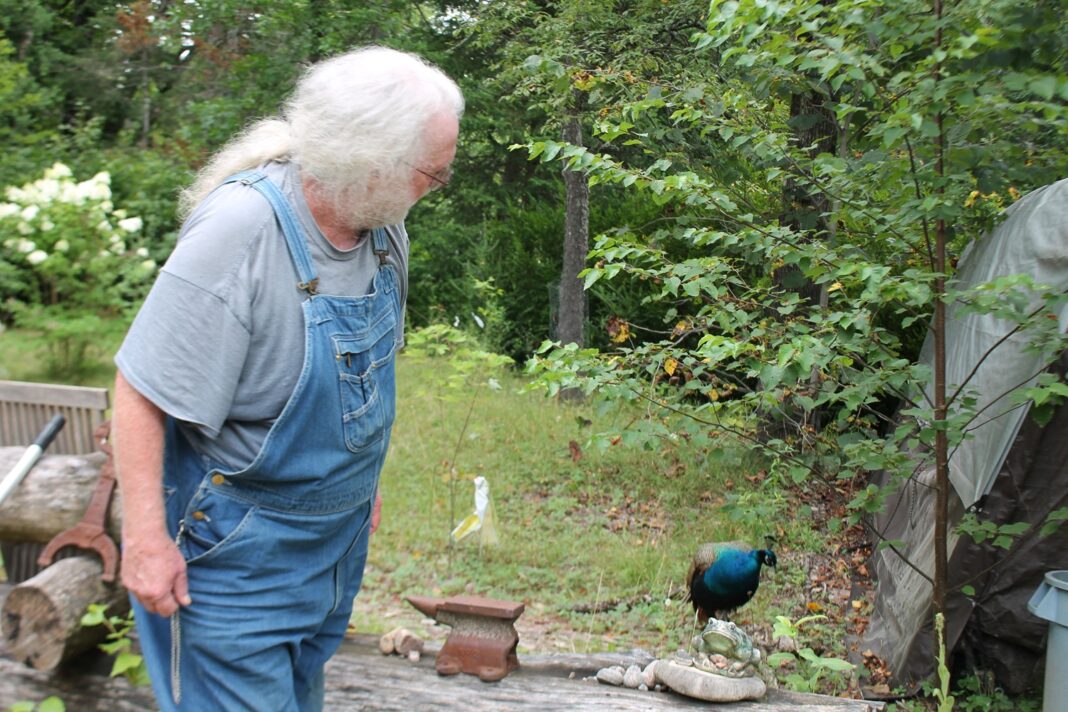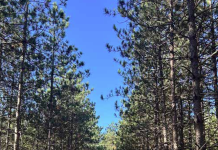David Hyland is still scratching his head over how a peacock missing tail feathers showed up at his property Aug. 5.
Hyland called The Highlander this past Tuesday to ask if the paper knew of anyone, or any wildlife organization, that could come take the bird to ensure its care and safety. He had been feeding and watering it since the Civic Holiday Monday.
He said that’s when his wife, told him, “there’s a peacock on the lawn” of their home near Furnace Falls. He went out to investigate and discovered it was indeed a “real peacock … a great big male peacock.”
Hyland noted the majority of the bird’s tail feathers were missing. He thinks they were cut off because there appeared to be a straight line. He added while not an expert, he estimates the remaining feathers at fourto-six feet long. Peacock feathers can reach five feet or 1.7 metres in length. “Highly decorative,” he added.
Peacocks do tend to shed their feathers naturally in a process called molting. The shedding process begins every year after mating season, between February and August.
While he has no proof, Hyland suspects the bird was stolen from somewhere and dumped along Hwy. 503.
He said it was an unusual sight as peacocks are not native to Ontario. In fact, the peafowl are native to Sri Lanka and India, where they are the national bird. In Ontario, peacocks are not permitted as pets but may be kept on agricultural properties.
His son told him the bird is probably worth $3,000 to $4,000, According to an internet site, Peacock Farming, they can cost up to $5,000.
Hyland said, “that belongs to somebody. It is tame. It eats Cheerios and grapes … what else does it like? I had it penned up in my raspberry patch last night but he got out, jumped over the fence. He wiped out all my raspberries. He’s also pecking at the side of my truck because he sees himself in the paint.”
Birds are known to defend their territory, and will attack and try to drive away any bird they view as a possible competitor. When they see their own reflection, they assume they’re seeing a competitor and can attack the image.
Hyland added, “he’s not afraid of me. He’s cautious. He won’t let me go up and touch him, but I can stand three or four feet beside him and talk to him and he seems to be comfortable.”
As Hyland walks around his rural property, he spots the peacock laying in the bush near the river. The bird emerges and walks into the grass adjacent to a trailer on the property. The missing tail feathers are visible.
“He’s somebody’s dear pet of some kind. It’s so, so, weird,” Hyland said.
“My son, who is into birds, told me if you ever find an ostrich feather on your lawn in some countries, it’s the luckiest thing that could ever happen to you and your property. I found a whole bird,” he says with a loud chuckle.
Monika Melichar of Woodlands Wildlife Sanctuary said people do have peacocks on farms, and said it sounded like the bird was a domestic animal. As such, they cannot take it in as a rescue.
When googling what to do when you find a peacock on your property, it comes up as “the first step will be to try and locate the owners. They may actually live a few miles from where the birds are gathering as peafowl have quite large territories. As peafowl are non-native it is illegal to allow them to escape into the wild so the owner should take responsibility for them.”
In Ontario, people can report suspected animal cruelty to the OSPCA at 1-833-9264625.





